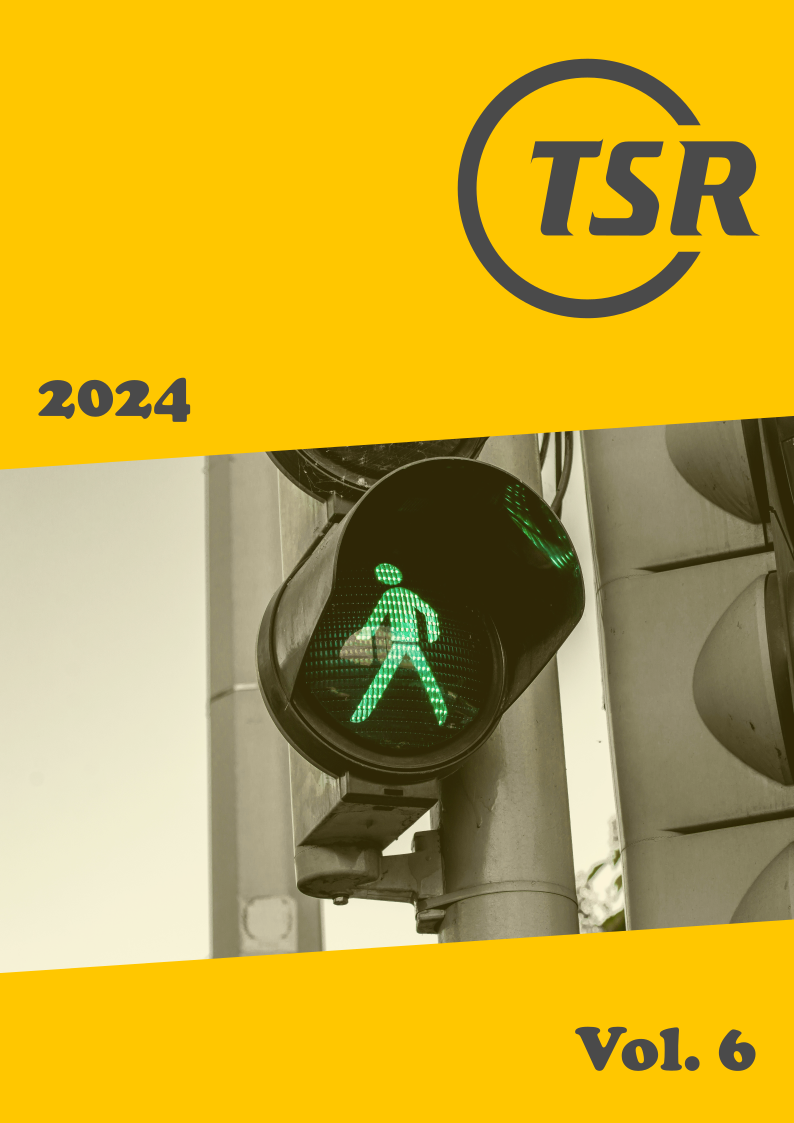Pedestrian's travel distances and risk of falls in snowy and icy conditions in German cities
DOI:
https://doi.org/10.55329/tled9982Keywords:
distance walked, injury severity, pedestrian injury, pedestrian safety, single pedestrian accidents, survey effects, winter walkingAbstract
Walking as a sustainable, space-efficient and generally healthy mode of transport is promoted throughout the whole year. However, only a few studies provide findings on the impact of snowy or icy surfaces on pedestrian's volumes and their risk of falls, especially in central Europe. To address this gap, multiple data sources have been analysed: travel diaries of 22 772 respondents to a recurring German Household Travel Survey, information on travel behavior and experienced pedestrian falls of 3 333 respondents to additional dedicated online and field surveys as well as manual counts from 65 hours of video footage collected at 13 sites. Depending on the data source, no changes or slight increases in pedestrian traffic have been found in snowy/icy conditions. We determined a risk of at least 7.8 falls per 10 000 km walked in snowy/icy conditions, which is about 32 times higher compared to other weather conditions. However, the overall share of medical treatment did not differ significantly by weather condition. Pedestrians aged 65 and older tend to have a lower overall risk of falls but are more likely to receive medical treatment in case of a fall. The calculated risk of falls differs greatly depending on survey type (online vs field) and timing (during snow/ice vs during other weather). Including pedestrian stages of Public Transport and Motorized Individual Transport trips significantly influences the study results and we assume leads to more realistic results. While pedestrian falls are generally not recorded by the police, only those that caused medical treatment were reported to insurers. The findings underline the importance of winter maintenance on pedestrian facilities to promote walking throughout the whole year.
Downloads
References
Ahrens, G.-A., F. Ließke, R. Wittwer, S. Hubrich, S. Wittig (2014), 'Tabellenbericht zum Forschungsprojekt “Mobilität in Städten - SrV 2013” in der Landeshauptstadt Dresden', Technische Universität Dresden, Lehrstuhl Verkehrs- und Infrastrukturplanung.
Ahrens, G.-A., R. Wittwer, S. Hubrich, S. Wittig, F. Ließke (2015), 'Sonderauswertung zum Forschungsprojekt “Mobilität in Städten-SrV 2013”. Stadtgruppe: SrV-Städtepegel', Technische Universität Dresden, Lehrstuhl Verkehrs- und Infrastrukturplanung.
Aldred, R. (2018), 'Inequalities in self-report road injury risk in Britain: A new analysis of National Travel Survey data, focusing on pedestrian injuries', Journal of Transport & Health, 9, 96–104. DOI: https://doi.org/10.1016/j.jth.2018.03.006
Aultman-Hall, L., D. Lane, R. R. Lambert (2009), 'Assessing Impact of Weather and Season on Pedestrian Traffic Volumes', Transportation Research Record: Journal of the Transportation Research Board, 2140(1), 35–43. DOI: https://doi.org/10.3141/2140-04
Baier, R., K. Schäfer, A. Klemps-Kohnen (2009), 'Verbesserung der Verkehrssicherheit älterer Verkehrsteilnehmer', Unfallforschung der Versicherer.
Bärwolff, M., R. Gerike (2023), 'Cyclist’s travel distances and risk of falls in snowy and icy conditions in German cities', Journal of Safety Research, 87, 64–75. DOI: https://doi.org/10.1016/j.jsr.2023.09.005
Bärwolff, M., A. Reinartz, R. Gerike (2022), 'Correlates of Pedestrian and Cyclist Falls in Snowy and Icy Conditions', Transactions on Transport Sciences, 12(3), 67–77. DOI: https://doi.org/10.5507/tots.2021.007
Berntman, M. (2003), 'Consequences of Traffic Casualties in Relation to Traffic-Engineering Factors - An Analysis in Short-term and Long-term Perspectives', Lund University, Sweden, PhD thesis.
Böcker, L., M. Dijst, J. Prillwitz (2013), 'Impact of Everyday Weather on Individual Daily Travel Behaviours in Perspective: A Literature Review', Transport Reviews, 33(1), 71–91. DOI: https://doi.org/10.1080/01441647.2012.747114
Bongiorno, C., D. Santucci, F. Kon, P. Santi, C. Ratti (2019), 'Comparing bicycling and pedestrian mobility: Patterns of non-motorized human mobility in Greater Boston', Journal of Transport Geography, 80, 102501. DOI: https://doi.org/10.1016/j.jtrangeo.2019.102501
Brög, W. (2017), 'Das hauptsächlich vernachlässigte Verkehrsmittel - Die Bedeutung des Fußverkehrs und die Nutzung des Straßenraums', Bundesweiter Umwelt- und Verkehrskongress, Wuppertal.
Bull, F. C., S. S. Al-Ansari, S. Biddle, K. Borodulin, M. P. Buman, G. Cardon, C. Carty, J. P. Chaput, S. Chastin, R. Chou (2020), 'World Health Organization 2020 guidelines on physical activity and sedentary behaviour', British Journal of Sports Medicine, 54(24), 1451–1462. DOI: https://doi.org/10.1136/bjsports-2020-102955
Cools, M., E. Moons, L. Creemers, G. Wets (2010), 'Changes in Travel Behavior in Response to Weather Conditions: Do Type of Weather and Trip Purpose Matter? Transportation Research Record', Transportation Research Record: Journal of the Transportation Research Board, 2157(1), 22–28. DOI: https://doi.org/10.3141/2157-03
Creemers, L., G. Wets, M. Cools (2015), 'Meteorological variation in daily travel behaviour: Evidence from revealed preference data from the Netherlands', Theoretical and Applied Climatology, 120, 183–194. DOI: https://doi.org/10.1007/s00704-014-1169-0
Duckham, R. L., E. Procter-Gray, M. T. Hannan, S. G. Leveille, L. A. Lipsitz, W. Li (2013), 'Sex differences in circumstances and consequences of outdoor and indoor falls in older adults in the MOBILIZE Boston cohort study', BMC Geriatrics, 13(1), 133. DOI: https://doi.org/10.1186/1471-2318-13-133
Eilert-Petersson, E., L. Schelp (1998), 'An epidemiological study of non-fatal pedestrian injuries', Safety Science, 29(2), 14–23. DOI: https://doi.org/10.1016/S0925-7535(98)00014-9
Elvik, R., T. Bjørnskau (2019), 'Risk of pedestrian falls in Oslo, Norway: Relation to age, gender and walking surface condition', Journal of Transport & Health, 12, 359–370. DOI: https://doi.org/10.1016/j.jth.2018.12.006
Eriksson, J., G. Sörensen (2015), 'Vintervädrets betydelse för att fotgängare skadas i singelolyckor', vti.
ERSO, (2023), 'Annual statistical report on road safety in the EU, 2022', European Road Safety Observatory.
Feleke, R., S. Scholes, M. Wardlaw, J. S. Mindell (2018), 'Comparative fatality risk for different travel modes by age, sex, and deprivation', Journal of Transport & Health, 8, 307–320. DOI: https://doi.org/10.1016/j.jth.2017.08.007
Fieller, E. C. (1940), 'The Biological Standardization of Insulin', Supplement to the Journal of the Royal Statistical Society, 7(1). DOI: https://doi.org/10.2307/2983630
Furian, G., A. Kühnelt-Leddhin, R. Bauer (2011), 'Das Unfallrisiko auf Fußwegen in Österreich', Abschlussbericht zum Forschungsprojekt des Österreichischen Verkehrssicherheitsfonds, Bundesministerium für Verkehr.
Ganz, D. A., T. Higashi, L. Z. Rubenstein (2005), 'Monitoring Falls in Cohort Studies of Community-Dwelling Older People: Effect of the Recall Interval', Journal of the American Geriatrics Society, 53(12), 2190–2194. DOI: https://doi.org/10.1111/j.1532-5415.2005.00509.x
Gao, J., C. B. M. Kamphuis, M. Dijst, M. Helbich (2018), 'The role of the natural and built environment in cycling duration in the Netherlands', International Journal of Behavioral Nutrition and Physical Activity, 15, 82. DOI: https://doi.org/10.1186/s12966-018-0715-z
Gascon, M., T. Götschi, A. D. Nazelle, E. Gracia, A. Ambròs, S. Márquez, O. Marquet, I. Avila-Palencia, C. Brand, F. Iacorossi, E. Raser, M. Gaupp-Berghausen, E. Dons, M. Laeremans, S. Kahlmeier, J. Sánchez, R. Gerike, E. Anaya-Boig, L. I. Panis, M. Nieuwenhuijsen (2019), 'Correlates of Walking for Travel in Seven European Cities: The PASTA Project', Environmental Health Perspectives, 127(9). DOI: https://doi.org/10.1289/EHP4603
Gyllencreutz, L., J. Björnstig, E. Rolfsman, B. Saveman (2015), 'Outdoor pedestrian fall-related injuries among Swedish senior citizens - injuries and preventive strategies', Scandinavian Journal of Caring Sciences, 29(2), 225–233. DOI: https://doi.org/10.1111/scs.12153
Hong, J. (2016), 'How does the seasonality influence utilitarian walking behaviour in different urbanization settings in Scotland?', Social Science & Medicine, 162, 143–150. DOI: https://doi.org/10.1016/j.socscimed.2016.06.024
Jacobsen, S. J., D. J. Sargent, E. J. Atkinson, W. M. O'fallon, L. J. Melton (1995), 'Population-based Study of the Contribution of Weather to Hip Fracture Seasonality', American Journal of Epidemiology, 141(1), 79–83. DOI: https://doi.org/10.1093/oxfordjournals.aje.a117348
Koszowski, C., R. Gerike, S. Hubrich, T. Götschi, M. Pohle, R. Wittwer (2019), 'Active Mobility: Bringing Together Transport Planning, Urban Planning, and Public Health', Towards user-centric transport in Europe, Springer International Publishing, pp. 149-171. DOI: https://doi.org/10.1007/978-3-319-99756-8_11
Koszowski, C., S. Hubrich, R. Wittwer, R. Gerike (2024), 'From Trips to Stages: A Methodology for Generating Stage Information in Trip-Based Household Travel Surveys', Manuscript submitted for publication. DOI: https://doi.org/10.1007/s11116-024-10567-5
Liu, C., Y. O. Susilo, A. Karlström (2015), 'Investigating the impacts of weather variability on individual’s daily activity-travel patterns: A comparison between commuters and non-commuters in Sweden', Transportation Research Part A: Policy and Practice, 82, 47–64. DOI: https://doi.org/10.1016/j.tra.2015.09.005
Liu, C., Y. O. Susilo, A. Karlström (2017), 'Weather variability and travel behaviour - what we know and what we do not know', Transport Reviews, 37(6), 715–741. DOI: https://doi.org/10.1080/01441647.2017.1293188
Methorst, R., P. Schepers, N. Christie, M. Dijst, R. Risser, D. Sauter, B. V. Wee (2017), '“Pedestrian falls” as necessary addition to the current definition of traffic crashes for improved public health policies', Journal of Transport & Health, 6, 10–12. DOI: https://doi.org/10.1016/j.jth.2017.02.005
Mindell, J. S., D. Leslie, M. Wardlaw (2012), 'Exposure-Based, “Like-for-Like” Assessment of Road Safety by Travel Mode Using Routine Health Data', PLoS ONE, 7(12), 50606. DOI: https://doi.org/10.1371/journal.pone.0050606
Miranda-Moreno, L. F., D. Fernandes (2011), 'Modeling of Pedestrian Activity at Signalized Intersections: Land Use, Urban Form, Weather, and Spatiotemporal Patterns', Transportation Research Record: Journal of the Transportation Research Board, 2264(1), 74–82. DOI: https://doi.org/10.3141/2264-09
Miranda-Moreno, L. F., A. C. Lahti (2013), 'Temporal trends and the effect of weather on pedestrian volumes: A case study of Montreal Canada', Transportation Research Part D: Transport and Environment, 22, 54–59. DOI: https://doi.org/10.1016/j.trd.2013.02.008
Naumann, R. B., A. M. Dellinger, T. Haileyesus, G. W. Ryan (2011), 'Older adult pedestrian injuries in the United States: Causes and contributing circumstances', International Journal of Injury Control and Safety Promotion, 18(1), 65–73. DOI: https://doi.org/10.1080/17457300.2010.517321
Öberg, G., G. Nilsson, H. Velin, P. Wretling, M. Berntmann, K. Brundell-Freij, C. Hyden, A. Staahl (1996), 'Single accidents among pedestrians and cyclists', vti, VTI meddelande 799A.
Oxley, J., S. O'hern, D. Burtt, B. Rossiter (2018), 'Falling while walking: A hidden contributor to pedestrian injury', Accident Analysis & Prevention, 114, 77–82. DOI: https://doi.org/10.1016/j.aap.2017.01.010
Pajala, S., P. Era, M. Koskenvuo, J. Kaprio, T. Tormakangas, T. Rantanen (2008), 'Force Platform Balance Measures as Predictors of Indoor and Outdoor Falls in Community-Dwelling Women Aged 63-76 Years', The Journals of Gerontology Series A: Biological Sciences and Medical Sciences, 63(2), 171–178. DOI: https://doi.org/10.1093/gerona/63.2.171
Sabir, M. (2011), 'Weather and travel behaviour', Vrije Universiteit Amsterdam, the Netherlands, PhD thesis.
Saneinejad, S., M. J. Roorda, C. Kennedy (2012), 'Modelling the impact of weather conditions on active transportation travel behaviour', Transportation Research Part D: Transport and Environment, 17(2), 129–137. DOI: https://doi.org/10.1016/j.trd.2011.09.005
Schepers, P., B. D. Brinker, R. Methorst, M. Helbich (2017), 'Pedestrian falls: A review of the literature and future research directions', Journal of Safety Research, 62, 227–234. DOI: https://doi.org/10.1016/j.jsr.2017.06.020
Schneider, R. J., T. Henry, M. F. Mitman, L. Stonehill, J. Koehler (2012), 'Development and Application of Volume Model for Pedestrian Intersections', Transportation Research Record: Journal of the Transportation Research Board, 2299(1), 65–78. DOI: https://doi.org/10.3141/2299-08
Shaaban, K., D. Muley, D. Elnashar (2018), 'Evaluating the effect of seasonal variations on walking behaviour in a hot weather country using logistic regression', International Journal of Urban Sciences, 22(3), 382–391. DOI: https://doi.org/10.1080/12265934.2017.1403363
Sim, D., J. Gehl (2019), Soft City: Building Density for Everyday Life, (Washington D.C, USA: Island Press).
Termida, N. A., Y. O. Susilo, J. P. Franklin, C. Liu (2018), 'Understanding seasonal variation in individual's activity participation and trip generation by using four consecutive two-week travel diary', Travel Behaviour and Society, 12, 52–63. DOI: https://doi.org/10.1016/j.tbs.2017.12.006
Wetterdienst, D. (2018), 'Weather data obtained from Deutscher Wetterdienst-DWD WESTE-XL', Deutscher Wetterdienst-DWD WESTE-XL.
Published
How to Cite
Issue
Section
License
Copyright (c) 2024 Martin Bärwolff, Regine Gerike

This work is licensed under a Creative Commons Attribution 4.0 International License.
Funding data
-
Bundesanstalt für Straßenwesen
Grant numbers FE 89.0308/2015









